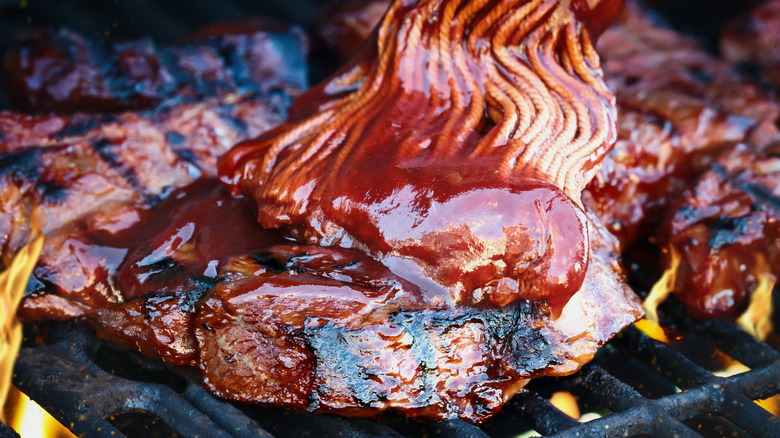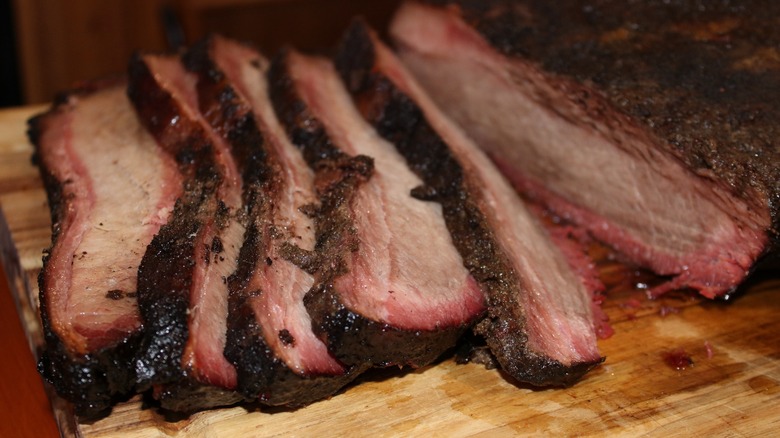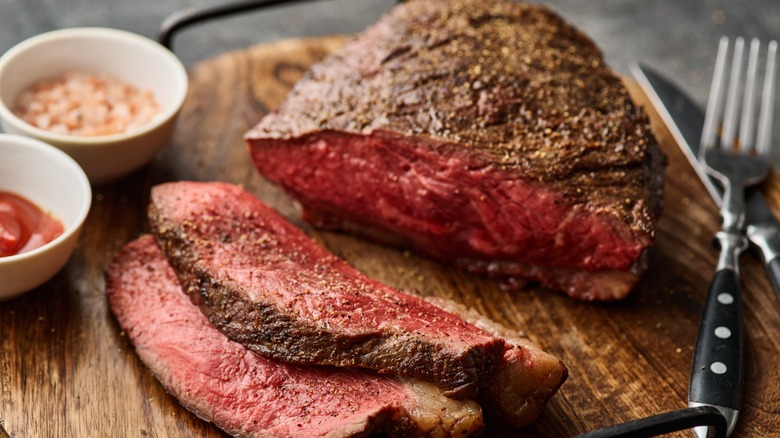Your Barbecue Meat Isn't Complete Without This Essential Sauce
We're all at least somewhat familiar with using marinades, dry rubs, and barbecue sauces as preparations for meat, but have you ever heard of mopping it? We're not talking about cleaning the kitchen floor, although "mopping" did earn its name from the use of the same household tool. In the world of grilling, a mop sauce is a thin sauce that's applied to meats during the cooking or smoking process. The goal of a mop sauce is to add moisture to meat to keep it from drying out as it cooks. It also serves to add flavor to your smoked Texas BBQ brisket or pulled pork shoulder.
Mop sauce can be used on all types of grilled meats, but it's most commonly used for large, slow-cooked cuts. Whether you're using a smoker or indirect heat on a gas or charcoal grill, a mop sauce will help provide the savory, rich essence desireable in grilled ribs and chuck roast. To use a mop sauce effectively, you'll want to maintain a balance between ingredients, use the right tool, and apply it at the right time.
What's in a barbecue mop sauce?
Although magicians rarely share the secrets to their tricks, grill masters don't tend to keep their mop sauces under a veil of mystery. There are plenty of recipes available; and just like there are countless variations of barbecue sauces, a mop sauce can take a different form based on the type of meat you're cooking, the ingredients you have on hand, and your personal preferences.
In general, a mop sauce contains water or a broth. When cooking beef, you might want to pair it with a beef broth. In contrast, a pork butt might benefit from chicken stock. For acidity, a mop sauce normally includes some form of vinegar, wine, or juice. It might also include beer, Worcestershire sauce, ketchup, or soy sauce. Most recipes include seasonings, which might range from cilantro to cumin, paprika, garlic powder, or dry mustard. You'll also find some form of fat, whether it be a neutral oil or a butter. With varying ingredients, mop sauces can be sweet, spicy, smoky, or a combination of all three, but one thing they all are is thin. The consistency is similar to water or perhaps apple juice, so it absorbs into the meat rather than sitting on top of it.
How to mop your barbecue
With the right mop sauce at hand, the actual mopping is easier than cleaning the kitchen floor. Simply apply the sauce to the meat, repeating the application at regular intervals. The initial mop should take place after the meat has cooked long enough to form a crust so the dry rub has time to adhere to the meat and won't wash away with the mop. For slow-cooking meats, this usually happens after the first hour.
The sauce is called a mop, and the implement used to apply it is, too. The terms got their start in the early 1960's before and during the time Lyndon B. Johnson was president. LBJ enjoyed hosting large barbecues on his Texas ranch for friends, donors, and politicians. The events grew so large that his caterer and pit master, Walter Jetton, used an actual floor mop to apply the sauce to the rows of meat on the open grills.
Today we have a grilling essential that serves the same purpose — without the connection to floor grime. Mops can be made from cotton or silicone. They have a long enough handle to keep your hands out of the heat, and a mop head that holds on to the sauce just long enough to then release it onto the surface, creating a culmination of moisture and flavor barbecue is known for. So the next time you plan a backyard barbecue, plan on mixing up a mop sauce, grabbing a mop, and start mopping.


